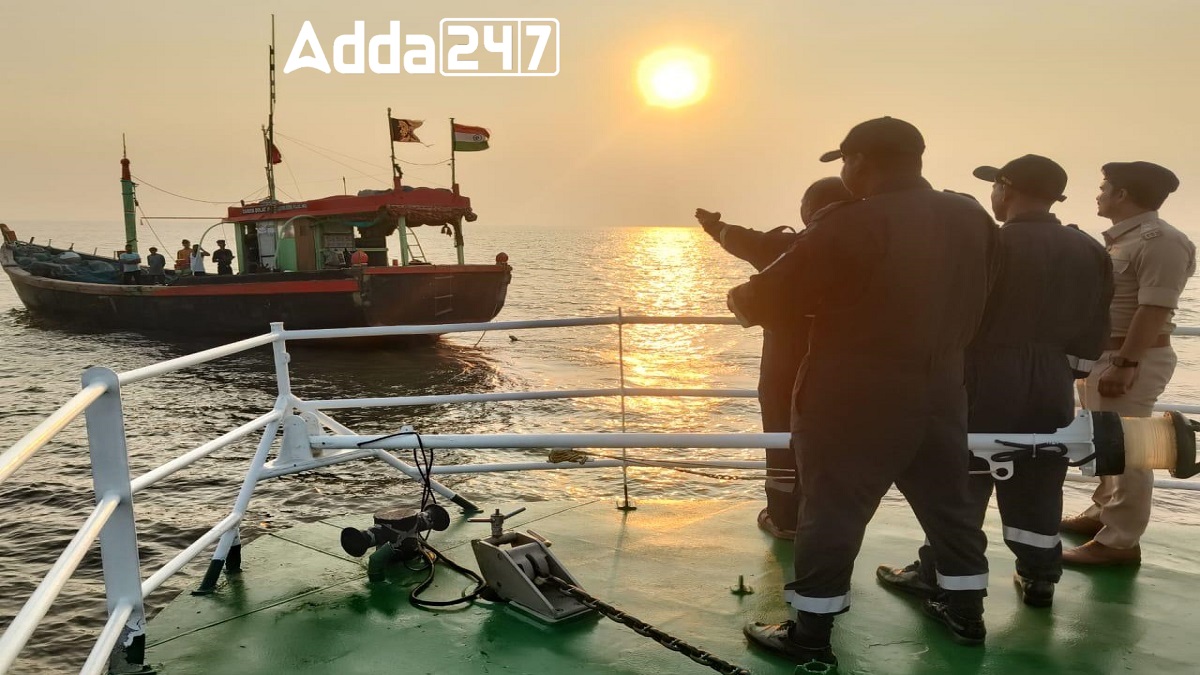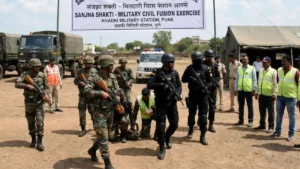The Indian Coast Guard successfully conducted the coastal security exercise ‘Sagar Kavach’ on October 16-17, covering Gujarat, Daman & Diu, as well as Goa and Maharashtra. The exercise aimed to enhance coastal and maritime security, improve coordination among agencies, and test existing Standard Operating Procedures (SOPs) in response to potential threats such as infiltration and smuggling. It involved a wide range of stakeholders, including the Indian Navy, State Police, Marine Police, and port authorities.
Objective of the Exercise
‘Sagar Kavach’ focused on sharpening maritime security preparedness through multi-agency drills, simulating real-life scenarios to validate operational coordination among stakeholders.
Participation and Assets
The exercise included active participation from agencies like the Navy, Border Security Force (BSF), National Security Guard (NSG), Intelligence Bureau (IB), and others, utilizing ships, boats, drones, and aircraft for surveillance.
Strategic Importance
The exercise demonstrated India’s commitment to safeguarding its maritime interests, evolving communication plans, and addressing potential security gaps along the coastline through enhanced awareness and collaboration among maritime agencies.
Sagar Kavach coastal security exercise
Objective: The primary aim of Sagar Kavach is to enhance maritime and coastal security preparedness, validate existing Standard Operating Procedures (SOPs), and ensure coordinated response to various maritime threats.
Conduct: The exercise is conducted by the Indian Coast Guard (ICG) and has seen two editions in 2024, with recent drills held on October 16-17 across Gujarat, Daman & Diu, and earlier along the coasts of Goa and Maharashtra.
Coordination: Sagar Kavach involves collaboration among multiple stakeholders, including:
- Indian Navy
- State Police
- Marine Police
- Border Security Force (BSF)
- National Security Guard (NSG)
- Intelligence Bureau (IB)
- Port authorities and local government departments
Assets Utilized: The exercise employs various assets, including:
- Ships and boats from the Indian Coast Guard and Navy
- Drones and aircraft for aerial surveillance
Operational Scenarios: Realistic scenarios are simulated during the exercise, including:
- Infiltration attempts
- Smuggling operations
- Piracy
- Natural disasters
- Terrorist threats
Focus on Communication: The exercise emphasizes developing a unified coastal security communication plan and fostering awareness and information sharing among different agencies.
Outcome: The initiative aims to achieve 100% effective patrolling along the coastline, identify security gaps, and interdict potential infiltrators, thereby ensuring the protection of India’s maritime interests.
Indian Coast Guard: Key Points
Formation: Established on February 1, 1977, under the Ministry of Defence.
Role: Protects India’s maritime interests and enforces maritime law, including anti-smuggling, anti-piracy, and environmental protection.
Operational Areas: Indian territorial waters, including its Exclusive Economic Zone (EEZ), extending up to 200 nautical miles from the coast.
Motto: “Vayam Rakshamah” (We Protect).
Headquarters: New Delhi.
Key Operations: Coastal surveillance, search and rescue, marine pollution control, and collaboration with Navy and other agencies.
Personnel: Approximately 15,000 active members.
Fleet: Over 150 ships and boats, with more than 60 aircraft.
Notable Exercises: ‘Sagar Kavach’ for coastal security and ‘Operation Olivia’ for sea turtle protection.
Current Director General: Rakesh Pal (as of 2024).
Key Highlights: ‘Sagar Kavach’ Coastal Security Exercise
| Key Highlights | Details |
|---|---|
| Exercise Conducted by | – Indian Coast Guard (ICG) on October 16-17, 2024. |
| Locations | – Gujarat, Daman & Diu, Goa, Maharashtra. |
| Objective | – Enhance maritime and coastal security. – Improve coordination among agencies. – Test SOPs for handling threats like infiltration and smuggling. |
| Participating Agencies | – Indian Navy, BSF, NSG, IB, State Police, Marine Police, and port authorities. |
| Assets Used | – Ships, boats, drones, and aircraft for surveillance. |
| Exercise Focus | – Operational scenarios include infiltration, smuggling, piracy, natural disasters, and terrorist threats. |
| Coordination Goal | – Validate SOPs, improve inter-agency communication and response to maritime threats. |
| Strategic Importance | – Strengthen coastal patrolling, identify security gaps, and interdict potential threats. |
| Indian Coast Guard Overview | – Established on February 1, 1977. – Role: Protects India’s maritime interests, including anti-smuggling and anti-piracy operations. – Fleet: Over 150 ships and boats, 60+ aircraft. – Headquarters: New Delhi. – Current Director General: Rakesh Pal (2024). |




 DRDO Successfully Tests Indigenous MPATG...
DRDO Successfully Tests Indigenous MPATG...
 Mumbai Marks Tri-Services Veterans Day w...
Mumbai Marks Tri-Services Veterans Day w...
 Exercise ‘Sanjha Shakti’ Held at Dighi H...
Exercise ‘Sanjha Shakti’ Held at Dighi H...







